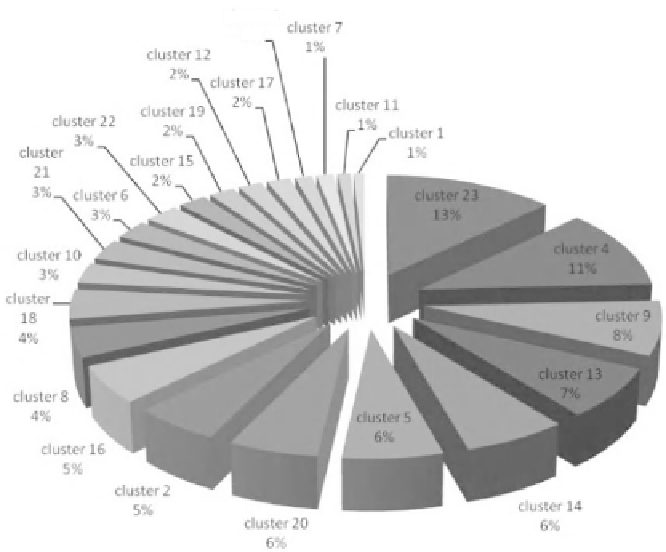Biology Reference
In-Depth Information
cluster 3
1%
cluster 7
1%
cluster 12
2%
cluster 17
2%
cluster 11
1%
cluster 19
2%
cluster 22
cluster 1
1%
3%
cluster
21
3%
cluster 15
2%
cluster 6
3%
cluster 23
13%
cluster
4
cluster 10
3%
11%
cluster
18
cluster
9
8%
4%
cluster
13
cluster 8
4%
7%
cluster
5
6%
cluster 16
5%
cluster 2
5%
cluster 14
6%
cluster 20
6%
Figure 12:
Pie charts representing percentage of each protein cluster identifi ed in
Spirulina platensis
after a heat shock at 40°C.
The protein clusters are classifi ed by the expression pattern of all signifi cant differentially expressed proteins in the plasma
membrane fraction
(clusters 7, 11, 12 and 21 are resistance proteins, cluster 22 is adaptation protein, clusters 1, 5, 6, 14, 15, 16,
18, 20 and 23 are sustained proteins, and clusters 2, 3, 4, 8, 9, 10, 13, 17 and 19 are undetermined protein trends)
.
With the kind
permission of A. Hongsthong, BEC Unit, National Center for Genetic Engineering and Biotechnology, 83 Moo8, Thakham,
Bangkhuntien, Bangkok 10150, Thailand. [Hongsthong
et al.
(2009)
Proteome Science
7:
33; doi:10.1186/1477-5956-7-33].
Color image of this figure appears in the color plate section at the end of the topic.
TM fraction. A decrease in the level of Δ
9
-desaturase that catalyzes the fi rst step in the fatty acid
desaturation in the PM and TM of this cyanobacterium was noted. Another down-regulated protein
belonged to uvrD/REP helicase that is known to be responsible for SOS response induced by UV
light (Crowley and Hanawalt, 2001), indicating that the DNA damage caused due to heat stress is
repaired by a repair system other than SOS repair.
III. OXIDATIVE STRESS
Of the ROS, the generation of O
2
•-
and
1
O
2
* mainly occurs in the photosynthetic electron transport
(PET) and during respiration in plants and cyanobacteria (Asada and Takahasi, 1987; Gutteriddge
and Halliwell, 1990; Shiraishi
et al
., 1994). These radicals subsequently give rise to H
2
O
2
and OH·.
The reaction of O
2
•-
with H
2
O
2
leads
to the formation of OH· which is often catalyzed by metal ions,
especially Fe
3+
. This is known as Fenton or Haber-Weiss reaction (Haliwell and Gutteridge, 1986). As
a consequence of this, all such enzymes and proteins in PET that possess iron will become the main
targets of O
2
•-
damage inside the cells (Haliwell and Gutteridge, 1986; Kuo
et al
., 1987; Fridovich, 1989;
Gutteridge and Haliwell, 1990; Gardner and Fridovich, 1991). The formation of
1
O
2
* in chlorophyll
antenna is due to the transfer of energy from excited triplet-state chlorophyll molecules to molecules








